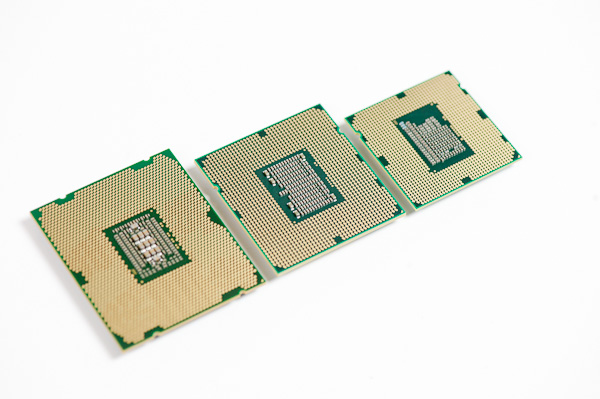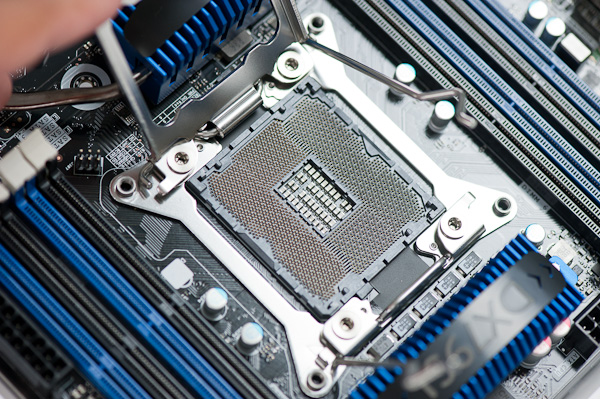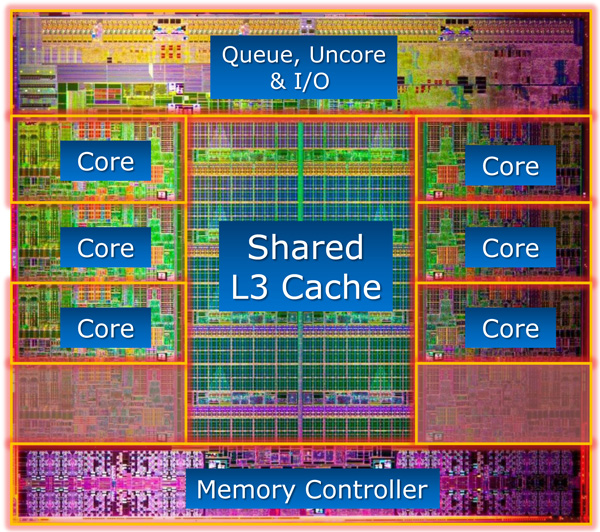Intel Core i7 3960X (Sandy Bridge E) Review: Keeping the High End Alive
by Anand Lal Shimpi on November 14, 2011 3:01 AM EST- Posted in
- CPUs
- Intel
- Core i7
- Sandy Bridge
- Sandy Bridge E
If you look carefully enough, you may notice that things are changing. It first became apparent shortly after the release of Nehalem. Intel bifurcated the performance desktop space by embracing a two-socket strategy, something we'd never seen from Intel and only once from AMD in the early Athlon 64 days (Socket-940 and Socket-754).
LGA-1366 came first, but by the time LGA-1156 arrived a year later it no longer made sense to recommend Intel's high-end Nehalem platform. Lynnfield was nearly as fast and the entire platform was more affordable.
When Sandy Bridge launched earlier this year, all we got was the mainstream desktop version. No one complained because it was fast enough, but we all knew an ultra high-end desktop part was in the works. A true successor to Nehalem's LGA-1366 platform for those who waited all this time.

Left to right: Sandy Bridge E, Gulftown, Sandy Bridge
After some delays, Sandy Bridge E is finally here. The platform is actually pretty simple to talk about. There's a new socket: LGA-2011, a new chipset Intel's X79 and of course the Sandy Bridge E CPU itself. We'll start at the CPU.
For the desktop, Sandy Bridge E is only available in 6-core configurations at launch. Early next year we'll see a quad-core version. I mention the desktop qualification because Sandy Bridge E is really a die harvested Sandy Bridge EP, Intel's next generation Xeon part:
If you look carefully at the die shot above, you'll notice that there are actually eight Sandy Bridge cores. The Xeon version will have all eight enabled, but the last two are fused off for SNB-E. The 32nm die is absolutely gigantic by desktop standards, measuring 20.8 mm x 20.9 mm (~435mm^2) Sandy Bridge E is bigger than most GPUs. It also has a ridiculous number of transistors: 2.27 billion.
Around a quarter of the die is dedicated just to the chip's massive L3 cache. Each cache slice has increased in size compared to Sandy Bridge. Instead of 2MB, Sandy Bridge E boasts 2.5MB cache slices. In its Xeon configuration that works out to 20MB of L3 cache, but for desktops it's only 15MB. That's just 1MB shy of how much system memory my old upgraded 386-SX/20 had.
| CPU Specification Comparison | ||||||||
| CPU | Manufacturing Process | Cores | Transistor Count | Die Size | ||||
| AMD Bulldozer 8C | 32nm | 8 | 1.2B* | 315mm2 | ||||
| AMD Thuban 6C | 45nm | 6 | 904M | 346mm2 | ||||
| AMD Deneb 4C | 45nm | 4 | 758M | 258mm2 | ||||
| Intel Gulftown 6C | 32nm | 6 | 1.17B | 240mm2 | ||||
| Intel Sandy Bridge E (6C) | 32nm | 6 | 2.27B | 435mm2 | ||||
| Intel Nehalem/Bloomfield 4C | 45nm | 4 | 731M | 263mm2 | ||||
| Intel Sandy Bridge 4C | 32nm | 4 | 995M | 216mm2 | ||||
| Intel Lynnfield 4C | 45nm | 4 | 774M | 296mm2 | ||||
| Intel Clarkdale 2C | 32nm | 2 | 384M | 81mm2 | ||||
| Intel Sandy Bridge 2C (GT1) | 32nm | 2 | 504M | 131mm2 | ||||
| Intel Sandy Bridge 2C (GT2) | 32nm | 2 | 624M | 149mm2 | ||||
Update: AMD originally told us Bulldozer was a 2B transistor chip. It has since told us that the 8C Bulldozer is actually 1.2B transistors. The die size is still accurate at 315mm2.
At the core level, Sandy Bridge E is no different than Sandy Bridge. It doesn't clock any higher, L1/L2 caches remain unchanged and per-core performance is identical to what Intel launched earlier this year.
The Lineup
| Processor | Core Clock | Cores / Threads | L3 Cache | Max Turbo | Max Overclock Multiplier | TDP | Price |
| Intel Core i7 3960X | 3.3GHz | 6 / 12 | 15MB | 3.9GHz | 57x | 130W | $990 |
| Intel Core i7 3930K | 3.2GHz | 6 / 12 | 12MB | 3.8GHz | 57x | 130W | $555 |
| Intel Core i7 3820 | 3.6GHz | 4 / 8 | 10MB | 3.9GHz | 43x | 130W | TBD |
| Intel Core i7 2700K | 3.5GHz | 4 / 8 | 8MB | 3.9GHz | 57x | 95W | $332 |
| Intel Core i7 2600K | 3.4GHz | 4 / 8 | 8MB | 3.8GHz | 57x | 95W | $317 |
| Intel Core i7 2600 | 3.4GHz | 4 / 8 | 8MB | 3.8GHz | 42x | 95W | $294 |
| Intel Core i5 2500K | 3.3GHz | 4 / 4 | 6MB | 3.7GHz | 57x | 95W | $216 |
| Intel Core i5 2500 | 3.3GHz | 4 / 4 | 6MB | 3.7GHz | 41x | 95W | $205 |
Those of you buying today only have two options: the Core i7-3960X and the Core i7-3930K. Both have six fully unlocked cores, but the 3960X gives you a 15MB L3 cache vs. 12MB with the 3930K. You pay handsomely for that extra 3MB of L3. The 3960X goes for $990 in 1K unit quantities, while the 3930K sells for $555.
The 3960X has the same 3.9GHz max turbo frequency as the Core i7 2700K, that's with 1 - 2 cores active. With 5 - 6 cores active the max turbo drops to a respectable 3.6GHz. Unlike the old days of many vs. few core CPUs, there are no tradeoffs for performance when you buy a SNB-E. Thanks to power gating and turbo, you get pretty much the fastest possible clock speeds regardless of workload.
Early next year we'll see a Core i7 3820, priced around $300, with only 4 cores and a 10MB L3. The 3820 will only be partially unlocked (max OC multiplier = 4 bins above max turbo).


















163 Comments
View All Comments
Phylyp - Monday, November 14, 2011 - link
Good review, thanks. I'm researching a new gaming PC, so this review is timely. Right now, seeing the comparative performance of the 2600K vs 3960X makes me want to wait for Ivy Bridge's 2600K replacement to see what sort of VFM that offers, compared to the 3930K.DaFox - Monday, November 14, 2011 - link
> Here we see a 40% increase in performance over the 2600K and FX-1850.On Page 5.
StealthGhost - Monday, November 14, 2011 - link
I'm guessing by these results 2600k / 2500k is going to be a much better buy for gaming vs the 3930kThe 2600k setup (mobo/cpu) I have is, from the prices in the motherboard and CPU review, 485 dollars cheaper than a 3930k+lga2011mobo setup ($400 vs $885). More than double what I paid and while the review for that one isn't out yet, even the 3960x isn't worth double just for gaming (obviously not what it is made for but people will buy it for gaming anyways).
I'd like to see i7 930 vs the 3930k in the review if at all possible since that is the replacement, no? Obviously 2600k as well.
Any idea when that one will be up?
yankeeDDL - Monday, November 14, 2011 - link
Tomshardware had the exact same conclusion.The 3960X is a workhorse and, arguably, the fastest CPU available to desktops today, however, at $999 its value is just not there.
For a shademore than 1/2 its price you get something only marginally slower, and only in certain scenarios. Gamers, for example, have very little benefits from the extra $350 over the 3930.
StealthGhost - Monday, November 14, 2011 - link
Yeah according to their review in BF3 the $999 processor would give me 0 gains since I have one card (GTX 570). If I have 2 which I might later this month it would give me 3.5 fps more, but then I wouldn't be able to afford the 2nd card in the first place haha.Core scaling and cache useage isn't there yet for a lot of games I guess.
B3an - Monday, November 14, 2011 - link
It's pathetic that the new game engine used for BF3 dont even make use of more than 4 cores, or extra cache. And this engine is meant to be for future games... not impressed.Makaveli - Monday, November 14, 2011 - link
so why don't you design a better engine ??Anand Lal Shimpi - Monday, November 14, 2011 - link
As soon as we can get our hands on a 3930K sample :)iwod - Monday, November 14, 2011 - link
QuickSync is really for casual users only. It doesn't offer any advantage over x264 apart from the saved CPU time. x264 is faster then QuickSync with Ultrafast mode, with better quality, and much better quality with other mode then QuickSync can ever get.So QuickSync is good if i want to transfer my media files to my portable, where quality doesn't really matter since i have the original file backed up. It is used for convenience.
Anyone getting a SB-E and doing encoding would properly better off with x264 then QuickSync.
The next version of QuickSync is said to have vastly improved quality and speed.
Manabu - Tuesday, November 15, 2011 - link
Intel's QuickSync quality is somewhere around x264 superfast/veryfast, for the same bitrate. Ultrafast isnt the best tradeoff for speed and quality, as it gives up everything for speed.But I agree, someone with an Sandy Bridge E would be better off using x264 if he learns how to.
A good comparison on speed and quality between GPU and CPU only encoders:
http://www.behardware.com/articles/828-1/h-264-enc...
The only thing they missed is that, if you only care about quality, and not an specific filesize/bitrate, you should be using CRF, and not 2-pass, and much less one pass with --bitrate.